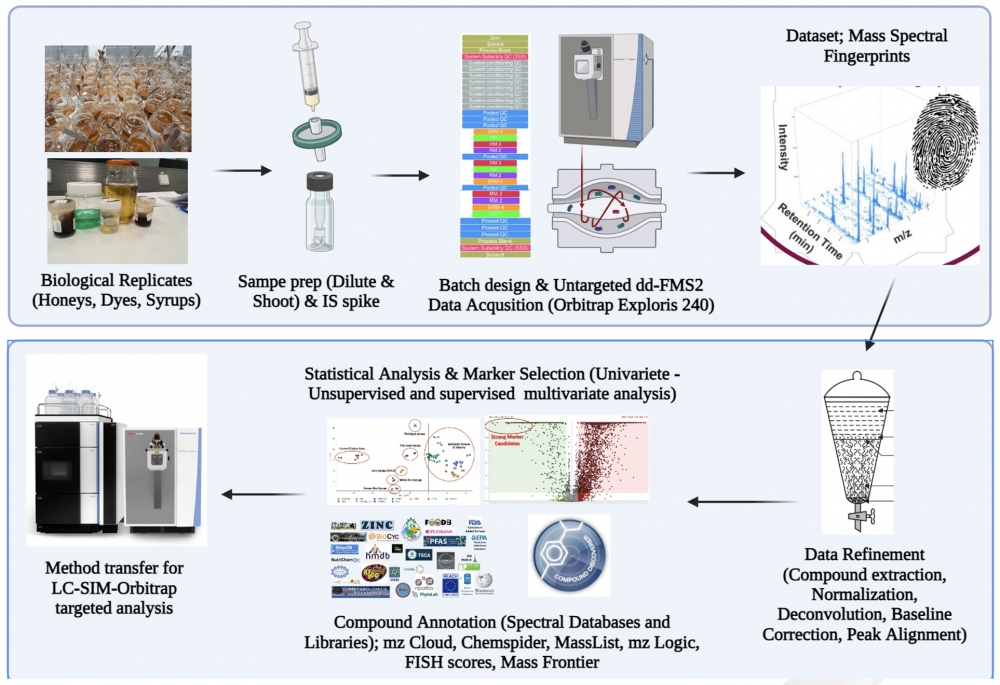JOURNAL 3050
Records of Agricultural and Food Chemistry
Year: 2024 Issue: 3 Special Issue: Abstracts 3rd. TCS, International Food Chemistry Congress February 29-March 03,2024 Antalya Türkiye
p.22 - 22
Viewed 930 times.
GRAPHICAL ABSTRACT

ABSTRACT
Fraudulent techniques are constantly evolving and the fact that QC activities have become the center of attention has necessitated the development of novel methods using modern instrumentation [1]. Currently, there are no practical and fruitful methods that can simultaneously highlight all common adulterants in honey by also declaring the adulteration origin leveraging a single shot analysis [2]. This work aimed to generate a non-sophisticated, qualitative screening method to confirm honey authenticity by exploiting a simple dilute & shoot preparation linked to a LC-SIM-MS acquisition. For this, we developed an analytical workflow starting with non-targeted metabolomic screening to underscore potential markers of honey adulteration. In the latter case, to integrate the final method into our QC workflows and possess a harmonizable nature, promising marker informations filtered from omic research were transferred to developed SIM-based targeted-MS method. Initially, the metabolomic profiles of food dyes, authentic honeys from different botanical origins, and as exogenous sugar syrups were obtained using HILIC separation coupled with Orbitrap HRMS system. For metabolomic runs, MS data acquisition was operated in a full MS-ddMS2 mode (top 5). Full scan spectrums were acquired in polarity switching from 90 to 1200 m/z at 180,000 FWHM. Detected markers were deeply criticized and selected visually after performing a data process using Compound Discoverer software. To conduct discriminant analysis, chemometric data processing tools including unsupervised PCA and volcano plots were used after log transformation. After the selection of the markers, targeted SIM-MS spectrums were acquired at a 15,000 FWHM using an inclusion list containing an m/z value and predicted RTs. Foreign polysaccharides in honey with an extended degree of polymerization (DP) were assumed as the accurate indicators of starch-based syrup usage. Fructooligosaccharides or maltooligosaccharide-type liquefied starch can be distinguished efficiently in our method by carefully analyzing the retention time indexes. Hence, starch-based syrups derived from different origins like agave, corn, rice, wheat, and cassava can also be distinguished by novel methods. For corn syrups, other than polysaccharide residues, 8 additional markers covering all corn syrup types (n=7) were selected. Again, other than polysaccharide residues, 5 discriminant markers for rice syrups suggested by the novel method. Furthermore, we realized that adding foreign amylases to artificially increase the diastase value of honey can preliminarily be reported by analyzing polysaccharide residues derived from the hydrolyzed starch content of the enzyme product. We defined 10 common markers for 7 different E150d dyes in place of imidazoles. Psicose and mannose were the rare monosaccharides and assumed as certain markers of inverted and corn syrups. These monosaccharides were also monitored in our method with improved resolution. Thin juice or thick juice obtained from beet rhizomes is used for invert sugar syrup production. The presented method in this study described 8 telltale markers and enabled detection of both beet syrup types. Acetyl maltose and anthranoside A along with caffeine were tentatively annotated and used as botanical origin markers for pine and citrus honey respectively. In the real sample analysis, carried out thanks to the new method, it was determined that most of the honeys in the market contained adulteration and this situation constituted a major problem in terms of food safety. The use of beet syrup was found to be the predominant type of adulteration. The described SIM-MS method using targeted multimarker detection represents a remarkable improvement over past analytical methods and reshaped the demonstrated approaches by providing a high degree of certainty in terms of adulteration identification.
KEYWORDS- Adulteration
- honey
- metabolomic
- sugar syrups
- LC-MS
- E150d